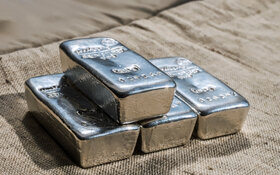The Gold Report: The price of gold fell more than 6% in March. To what do you attribute this?
Ted Dixon: Gold took a one-two punch in late March. The first was the widening of the renminbi trading ban in China by 2%, which added extra costs to buying and hedging gold. The second was the surprisingly hawkish tilt of the U.S. Federal Reserve, pointing to interest rates rising a little bit sooner. Tighter monetary conditions do not usually benefit gold.
TGR: Increased import duties in India haven't reduced gold buying there. Why would China be different?
TD: I think the flows are different. In China, there is a lot of financial activity related to gold, whereas in India gold buying is cultural and driven by consumer consumption.
TGR: We've heard about greatly increased governmental buying in China, have we not?
TD: There have been rumors of that, and the Chinese media has called for the government to boost its gold reserves. That could provide a longer-term counterbalance to the shorter-term renminbi pressure.
TGR: DataQuick's latest U.S. national homes sales snapshot shows that "prices are flatlining or drifting lower while sales are sinking like a stone." Meanwhile, "The big private equity firms [are] exiting the [housing] market." These data don't suggest a U.S. economic recovery, do they?
TD: Basically, insiders are telling us that stock prices now have priced in a lot of good news, so it would be interesting to see how they react to whips to the downside. One has to be cognizant that much of the U.S. equities rally has been driven by the Fed and, arguably, has little to do with GDP growth one way or the other.
TGR: With regard to this hawkish tilt, it has been assumed for several years that we'd see higher interest rates and an end to quantitative easing (QE) only after an economic recovery. Given how weak the U.S. economy remains, can we assume that the Fed believes it is close to exhausting the utility of zero interest rates and quantitative easing?
TD: The Fed has a big ticking time bomb on its balance sheet. It is still piling up reserves, and I'd love to be a fly on the wall in staff meetings that don't get reported. I have to assume there is much concern about what happens to those reserves, particularly if the economy does surprise on the upside. In this sense, the low-altitude economy has been a blessing for the Fed.
We may have a little game of bluff going on here. The Fed is taking a hawkish stance now, saying it has to move rates up earlier, but, of course, if the economy remains weak, and the Fed has to backtrack, that opens up risks on the other side. The Fed has been running a big monetary policy laboratory over the past few years, and sometimes in laboratories accidents happen. At this point, however, the stock market seems to have assigned a very little risk premium to something bad happening.
TGR: It has been argued that if you remove the Fed's monthly stimulus from the monthly GDP report, GDP is actually shrinking, not growing.
TD: The Fed has certainly manipulated the economy. It has picked its favorite sectors, housing and autos. I believe that Operation Twist and QE have hurt the commodities base because they have favored interest-sensitive industries. Now, however, these industries will have to stand on their own two feet, and we'll see how this experiment in industrial policy works out. Usually, planned economies have a day of reckoning when stimulative measures run out of steam.
TGR: Your company, INK Research, tracks the legally reported buying and selling by public company executives and institutional investors. What does this tell us about the status of individual companies in particular, and the gold sector in general?
TD: In general, U.S. market-insider indicators have been languishing at 25% for a long time. Insiders do not see very many bargains. This suggests that value strategies are going to be very important going forward if you're looking to make money in the broad market.
A year ago, in the gold sector, insider buying went through the roof as the prices of gold and gold equities tumbled down. This was a bit early, but it basically confirmed a bottom in the equities last spring. The S&P composite gold index finally moved above 1,800 and then pulled back, with some insider selling into that run-up. We're seeing a measured profit taking. It's nice that there can be some profit taking in the gold sector, given how beat up it's been, but money has come off the table, and that could foreshadow some short-term weakness.
TGR: As of March 24, 2014, your INK sentiment indicator of Toronto Stock Exchange (TSX)-listed stocks is 85.2%. What does that figure mean?
TD: It means there's less insider buying than trading. At 100%, you have an equal amount of insider buys and sales. So the indicator rating is Overvalued.
TGR: For the TSX Venture-listed stocks in total, the figure is 341.1%.
TD: Right. That includes not just gold stocks but also the other miners and technology and energy juniors. But the TSX Venture Exchange is heavily weighted toward junior mining.
For the overall TSX gold sector, the indicator is 250%. So we're seeing 2.5 companies with insider buying for every one that's selling. This means that gold stock insiders are still quite bullish, despite the recent pullback.
TGR: And that indicator reading equals Undervalued?
TD: Right. The junior miners have been toughing it out for years. The TSX Venture Index moved 20% above its 2013 lows in March, and it's been a long time coming. The insiders were early, but they're not packing their bags now.
TGR: You publish a list of Top 50 Insider Buys by dollar amount over the past 60 days. What's the significance of this?
TD: The dollar amount is a good initial screen to examine. Of course, you want to look at it with regard to the overall market cap of the company. So $1 million ($1M) bought in a large-cap company is not as significant as $1M bought in a medium- or micro-cap company. We also look at both the company's valuation and its price direction because they put the insiders' signals in context.
For example, if a stock is going up and there's a lot of insider buying, that could mean insiders are buying into the news. On the other hand, if the stock has fallen and there's a lot of insider buying, that could signal a value opportunity, that the market has overreacted. Then you want to dig a little deeper and see who specifically in the company is doing the buying.
TGR: Which gold and silver miners are in the Top 50 insider net buying by dollar volume as of March 24?
TD: B2Gold Corp. (BTG:NYSE; BTO:TSX; B2G:NSX) is No. 13 with $579,106, Wildcat Silver Corp. (WS:TSX.V) is No. 17 with $411,030, Premier Gold Mines Ltd. (PG:TSX) is No. 18 with $401,660, Barrick Gold Corp. (ABX:TSX; ABX:NYSE) is No. 25 with $335,720, IAMGOLD Corp. (IMG:TSX; IAG:NYSE) is No. 32 with $221,188, Treasury Metals Inc. (TML:TSX) is No. 35 with $192,760, Rusoro Mining Ltd. (RML:TSX.V) is No. 38 with $154,600 and Roxgold Inc. (ROG:TSX.V) is No. 48 with $120,000.
TGR: To what extent can insider buying be attributed to confirmation bias? In other words, this must be a good company, otherwise I wouldn't be working for it.
TD: That is something to be aware of. There may be examples of that, but we find that insiders tend to buy when they think they can make money. They are usually pretty picky, and they usually like to spot opportunities for bargains. And one has to keep in mind again that insiders tend to be early, and I think that's a more important consideration than confirmation bias.
The one big exception to this is when companies issue good news, and insiders buy. This could be a signal that the market hasn't yet fully priced in that news.
TGR: Pretty much every company in the list above has seen a significant share price fall in the second half of March. To what extent, particularly among the juniors and the micro caps, could insider buying be seen as an attempt to bolster investor confidence?
TD: That's why we must look at each stock individually. In addition, it's best to look at insider signals on a portfolio basis. We've found that when investors have a portfolio of stocks that use insider signals as a key input, they are going to have a few big winners, a number of stocks that do better than the market and a number that do worse. Investors certainly want to avoid the tendency to zero in on one company on an insider-buy basis and then put all their eggs in one basket. That would not be prudent.
TGR: How often do you track insider buying and selling?
TD: All our indicators are updated overnight, like a rolling poll. They are aggregated across the sectors, so they tend to even out company-specific situations. We update individual companies daily because, as I mentioned, when a news release comes out, it could change company fundamentals. So we want to see how insiders react to that change.
TGR: How about Barrick, in particular? It took a hit March 24 after a Barron's article cited a Credit Suisse Group analyst who continued to rate Barrick and Newmont Mining Corp. (NEM:NYSE) shares Neutral. Would the insider buying and selling in the days after this event be pretty significant?
TD: In our view, it would be. We don't consider analysts ratings' in our models, but investors can do both and compare, if they like.
TGR: What does it tell you when Barrick has had so much bad news lately, and yet it appears in the Top 50 list of insider buying by dollar amount?
TD: Well, insiders as a group are suggesting that the prospects for Barrick going forward are likely pretty good. It doesn't mean the numbers wouldn't get dragged down should the gold price take a tumble, but there's enough insider buying there for us to have put Barrick in the top 30% of all stocks we rank. Our rankings are not an investment recommendation, of course.
TGR: How about other majors? In your interview with The Gold Report last year you said that it was "nice to see" that Goldcorp Inc.'s (G:TSX; GG:NYSE) chairman had bought shares. How does this company look in that regard lately?
TD: We've seen with Goldcorp some insider selling related primarily to insider compensation. It's not unusual, but it has taken place at the same time as the post-December rally. Insider holdings at Goldcorp have remained fairly steady.
TGR: Which gold and silver miners are in your Top 50 insider net buying by share volume over the last 60 days as of March 24? There seem to be a lot of names, so how about only those in the first 25?
TD: Rusoro is No. 3 with 5,155,000; Quia Resources Inc. (QIA:TSX.V) is No. 6 with 3,920,000 shares; Manson Creek Resources Ltd. (MCK:TSX.V) is No. 17 with 1,679,500 shares; Currie Rose Resources Inc. (CUI:TSX.V) is No. 18 with 1,500,000 shares; Crown Gold Corp. (CWM:TSX.V) is No. 19 with 1,500,000 shares; Eskay Mining Corp. (ESK:TSX.V) is No. 20 with 1,460,000 shares; and Silver Predator Corp. (SPD:TSX) is No. 22 with 1,395,000 shares.
TGR: How significant is this data?
TD: Actual volume is another good first screening, but most of the companies that appear here tend to be small. When stocks are light traders with market caps under $20M, you've got to do more homework to ascertain what might be motivating insider activity. Is this company a value proposition, or is something else going on? You want to take a good look at the company's management and its cash position.
TGR: Arian Resources Corp. (ARC:TSX.V; 0GT1:FSE) closed a $2.78M private placement March 24. Of the 18M units sold, 800,000–that's $120,000 worth–were bought by members of that company's advisory board. What does this data tell us?
TD: I can't comment on a specific transaction, but, in general, when there are private placements you want to look at the terms. If they are reasonable, and management is participating, then it's positive. But, of course, every deal is different, so that's why we focus on public-market activity, which is more of a standard measure.
TGR: Your Top 3 INK Edge Quick Wins Q4/13 has Wesdome Gold Mines Ltd. (WDO:TSX) at No. 3, up 50%. What can you tell us about this?
TD: Our Morning Hour Report stocks use our INK Edge process, which looks at insider activity, valuation and price rank. We call it VIP criteria of valuation, insiders and price, and what we're looking for is the stocks that have insider buying that are good value and have good price strength. That's what we scour the market for every day.
TGR: So based on your various indices, which stocks stand out in insider buying, good value and good price strength?
TD: I'll repeat the caution that investors should take a diversified approach. I've already mentioned Barrick, which ranks quite well on our screens. Looking at other stocks with high amounts of key insider buying as of March 24, the company with the second-highest amount over the last 30 days is Endeavour Mining Corp. (EDV:TSX; EVR:ASX); it also has a mostly sunny outlook according to our INK Edge, which puts it in the top 30% of all stocks ranked.
Teranga Gold Corp. (TGZ:TSX; TGZ:ASX) is also in our top 30% of all stocks ranked. It has a mostly sunny INK Edge outlook. Arian Resources is No. 4 in insider buying and Amarillo Gold Corp. (AGC:TSX.V) is No. 5. But we do not rank the last two stocks due to their small sizes. These might be stocks for investors with very high risk tolerances to take a look at.
TGR: Ted, thank you for your time and your insights.
Ted Dixon is co-founder of INK Research (Insider News and Knowledge), Canada's first online financial news and research service dedicated to providing data on public company insider trading. (Free services are found on CanadianInsider.com and InsiderTracking.com.) He worked previously for Connor, Clark & Lunn Financial Group in portfolio strategy and product development, the Fraser Institute as an analyst, TD Bank as a treasury specialist and the Vancouver Stock Exchange as a floor trader. He has lectured in corporate finance at the BC Institute of Technology and is a Chartered Financial Analyst and member of CFA Vancouver. He holds a Master of Business Administration in financial management from the University of Chicago.
Read what other experts are saying about:
Want to read more Gold Report interviews like this? Sign up for our free e-newsletter, and you'll learn when new articles have been published. To see recent interviews with industry analysts and commentators, visit our Streetwise Interviews page.
DISCLOSURE:
1) Kevin Michael Grace conducted this interview for Streetwise Reports LLC, publisher of The Gold Report, The Energy Report, The Life Sciences Report and The Mining Report, and provides services to Streetwise Reports as an independent contractor. He owns, or his family owns, shares of the following companies mentioned in this interview: None.
2) The following companies mentioned in the interview are sponsors of Streetwise Reports: Premier Gold Mines Ltd. and Roxgold Inc. Goldcorp Inc. is not associated with Streetwise Reports. Streetwise Reports does not accept stock in exchange for its services.
3) Ted Dixon: I own, or my family owns, shares of the following companies mentioned in this interview: None. I personally am, or my family is, paid by the following companies mentioned in this interview: None. My company has a financial relationship with the following companies mentioned in this interview: None. I was not paid by Streetwise Reports for participating in this interview. Comments and opinions expressed are my own comments and opinions. I had the opportunity to review the interview for accuracy as of the date of the interview.
4) Interviews are edited for clarity. Streetwise Reports does not make editorial comments or change experts' statements without their consent.
5) The interview does not constitute investment advice. Each reader is encouraged to consult with his or her individual financial professional and any action a reader takes as a result of information presented here is his or her own responsibility. By opening this page, each reader accepts and agrees to Streetwise Reports' terms of use and full legal disclaimer.
6) From time to time, Streetwise Reports LLC and its directors, officers, employees or members of their families, as well as persons interviewed for articles and interviews on the site, may have a long or short position in securities mentioned. Directors, officers, employees or members of their families are prohibited from making purchases and/or sales of those securities in the open market or otherwise during the up-to-four-week interval from the time of the interview until after it publishes.










































